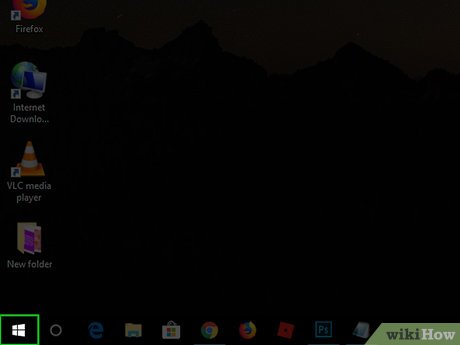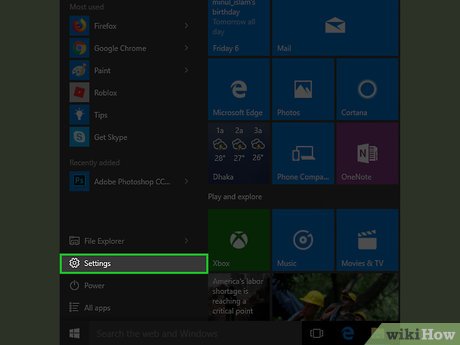How to Change or Create Desktop Icons for Windows
Method 1 of 6:
Changing System Desktop Icons
-
 Open Start. Click the Windows logo in the bottom-left corner of the screen, or press the ⊞ Win key.
Open Start. Click the Windows logo in the bottom-left corner of the screen, or press the ⊞ Win key.
-
 Click Settings. It's in the lower-left side of the Start window.
Click Settings. It's in the lower-left side of the Start window.
-
 Click Personalization. This is the monitor-shaped icon on the Windows Settings page.
Click Personalization. This is the monitor-shaped icon on the Windows Settings page.- You can also access this page by right-clicking a blank space on the desktop and then clicking Personalization in the drop-down menu.
-
 Click Themes. It's a tab on the left side of the Personalization window.
Click Themes. It's a tab on the left side of the Personalization window. -
 Click Desktop icon settings. This link is in the upper-right side of the Themes page. Clicking it opens the Desktop Icon Settings window.
Click Desktop icon settings. This link is in the upper-right side of the Themes page. Clicking it opens the Desktop Icon Settings window.- If you haven't edited your theme at all, this link will be in the middle of the page beneath the "Related Settings" heading.
- You can also click Get more themes in the Store below the "Apply a theme" heading to browse desktop themes. Some themes will change your desktop icons' appearances.
-
 Click an icon you want to change. This will select the icon.
Click an icon you want to change. This will select the icon.- For example, you might click This PC or Recycle Bin.
- You can also check the box next to a desktop icon's name at the top of the window to make it appear on your desktop, or uncheck the box to remove it from the desktop.
- Check the "Allow themes to change desktop icons" box on this window to enable theme-related icon changes.
-
 Click Change Icon. It's near the bottom of the window.
Click Change Icon. It's near the bottom of the window. -
 Select an icon. You can select two different types of icons:
Select an icon. You can select two different types of icons:- System icon - Click an icon in the window.
- Custom icon - Click Browse, then click the folder that your custom icons are in on the left side of the window. Select the icon you want to use, then click Open.
-
 Click OK. This will assign your selected icon to the desktop program.
Click OK. This will assign your selected icon to the desktop program. -
 Click Apply, then click OK. Doing so confirms your decision and changes the desktop program's icon to your selected icon.
Click Apply, then click OK. Doing so confirms your decision and changes the desktop program's icon to your selected icon.
Method 2 of 6:
Changing Shortcut and Folder Icons
-
 Open Start. Click the Windows logo in the bottom-left corner of the screen, or press ⊞ Win.
Open Start. Click the Windows logo in the bottom-left corner of the screen, or press ⊞ Win.
-
 Click the File Explorer. You'll find this icon on the far-left side of the Start window.
Click the File Explorer. You'll find this icon on the far-left side of the Start window.
-
 Click Desktop. It's a folder in the left-hand column of options in the File Explorer window.
Click Desktop. It's a folder in the left-hand column of options in the File Explorer window. -
 Click a shortcut or folder icon. Shortcut icons have a white box with an arrow in their lower-left corners.
Click a shortcut or folder icon. Shortcut icons have a white box with an arrow in their lower-left corners.- You cannot change the icons of specific files (e.g., Notepad files or .exe files) using this method.
-
 Click the Home tab. It's in the upper-left corner of the File Explorer window. Doing so will open a toolbar at the top of the window.
Click the Home tab. It's in the upper-left corner of the File Explorer window. Doing so will open a toolbar at the top of the window. -
 Click Properties. This is a white box with a red checkmark in the "Open" section of the toolbar.
Click Properties. This is a white box with a red checkmark in the "Open" section of the toolbar.- You can also right-click on the icon on your desktop and then click Properties to get to this menu.
-
 Open the icon's "Change Icon" window. This process will vary depending on the type of icon you're editing:
Open the icon's "Change Icon" window. This process will vary depending on the type of icon you're editing:- Shortcut - Click the Shortcut tab at the top of the Properties window, then click Change Icon near the bottom of the window.
- Folder - Click the Customize tab at the top of the Properties window, then click Change Icon near the bottom of the window.
-
 Select an icon. You can select two different types of icons:
Select an icon. You can select two different types of icons:- System icon - Click an icon in the window.
- Custom icon - Click Browse, then click the folder that your custom icons are in on the left side of the window. Select the icon you want to use, then click Open.
-
 Click OK. This will assign your selected icon.
Click OK. This will assign your selected icon. -
 Click Apply, then click OK. Doing so confirms your decision and changes the original icon to your selected icon.
Click Apply, then click OK. Doing so confirms your decision and changes the original icon to your selected icon.
Method 3 of 6:
Downloading Icons
-
 Open a web browser. Microsoft Edge is the official Windows 10 browser, though you can use Google Chrome, Firefox, Opera, or Internet Explorer as well.
Open a web browser. Microsoft Edge is the official Windows 10 browser, though you can use Google Chrome, Firefox, Opera, or Internet Explorer as well. -
 Search for Windows icons. Type download windows desktop icons into your browser's address bar and pressing ↵ Enter.
Search for Windows icons. Type download windows desktop icons into your browser's address bar and pressing ↵ Enter.- You can narrow your search by entering the program's name (e.g., windows my computer icon) or by using the icon file type (e.g., ICO.
-
 Download the icons you want. You can do this by opening a site that has your icons and clicking the Download button. Doing so will save the icons to your computer.
Download the icons you want. You can do this by opening a site that has your icons and clicking the Download button. Doing so will save the icons to your computer.- If you download multiple icons at once, you may have to extract the icons to a regular folder before continuing.
-
 Open File Explorer. You can do this by opening Start
Open File Explorer. You can do this by opening Start and clicking
and clicking .
.
-
 Click Desktop. This folder is on the left side of File Explorer.
Click Desktop. This folder is on the left side of File Explorer. -
 Click your icons folder. Doing so selects it.
Click your icons folder. Doing so selects it.- If you just downloaded one icon, select the icon instead.
-
 Click Home. This tab is in the upper-left corner of the File Explorer window.
Click Home. This tab is in the upper-left corner of the File Explorer window. -
 Click Move to. It's in the "Organize" section of the toolbar at the top of the File Explorer window.
Click Move to. It's in the "Organize" section of the toolbar at the top of the File Explorer window. -
 Click Pictures. This folder is near the middle of the pop-up window.
Click Pictures. This folder is near the middle of the pop-up window.- You can select any folder on your computer if you don't want to place your icons in Pictures.
-
 Click Move. This will send your icons to a folder where you won't move or delete them.
Click Move. This will send your icons to a folder where you won't move or delete them. -
 Change a program's icon using your downloaded icon. You'll use the Browse method and then select an icon from within the Pictures folder to do this.
Change a program's icon using your downloaded icon. You'll use the Browse method and then select an icon from within the Pictures folder to do this.
Method 4 of 6:
Creating Icons
-
 Open Start. Click the Windows logo in the bottom-left corner of the screen, or press ⊞ Win.
Open Start. Click the Windows logo in the bottom-left corner of the screen, or press ⊞ Win.
-
 Type paint into Start, then press ↵ Enter. Make sure you don't press ↵ Enter until the Paint icon, which resembles a paint palette, appears at the top of the Start window.
Type paint into Start, then press ↵ Enter. Make sure you don't press ↵ Enter until the Paint icon, which resembles a paint palette, appears at the top of the Start window. -
 Click File. It's a blue button in the upper-left corner of the Paint window.
Click File. It's a blue button in the upper-left corner of the Paint window. -
 Click Open. This option is in the File menu. Doing so opens a window where you can open a file location.
Click Open. This option is in the File menu. Doing so opens a window where you can open a file location.- If you'd rather create your own icon by drawing in Paint, skip this step and instead create your drawing.
-
 Select a picture. You may have to click a location on the left side of the Open window (e.g., Pictures) to find the picture you want to open.
Select a picture. You may have to click a location on the left side of the Open window (e.g., Pictures) to find the picture you want to open.- Skip this step if you're drawing your own icon.
-
 Click Open. This will open your image in the Paint window.
Click Open. This will open your image in the Paint window.- Skip this step if you're drawing your own icon.
-
 Click File again. It's in the top-left corner of Paint.
Click File again. It's in the top-left corner of Paint. -
 Select Save as. This option is near the top of the File menu.
Select Save as. This option is near the top of the File menu. -
 Click BMP picture. It's an option to the right of the Save as button. Doing so opens a Save As window where you can name your file.
Click BMP picture. It's an option to the right of the Save as button. Doing so opens a Save As window where you can name your file. -
 Type in your file's name followed by
Type in your file's name followed by.ico. This will ensure that your file is saved as an icon file.- For example, you might name your file "shortcut.ico".
-
 Click a folder to save your file in. Do so in the left-hand pane of the Save As window.
Click a folder to save your file in. Do so in the left-hand pane of the Save As window.- The Pictures folder is a safe place to save your shortcut file.
-
 Click Save. It's at the bottom of the window. Doing so will save your icon in your selected folder.
Click Save. It's at the bottom of the window. Doing so will save your icon in your selected folder. -
 Change a program's icon using your created icon. You'll use the Browse method and select your custom icon from the folder where you saved it.
Change a program's icon using your created icon. You'll use the Browse method and select your custom icon from the folder where you saved it.
Method 5 of 6:
Adding Shortcuts to the Desktop
-
 Open Start. Click the Windows logo in the bottom-left corner of the screen, or press ⊞ Win on your keyboard.
Open Start. Click the Windows logo in the bottom-left corner of the screen, or press ⊞ Win on your keyboard.
-
 Click File Explorer. It's in the lower-left side of the Start window.
Click File Explorer. It's in the lower-left side of the Start window.
-
 Click the Desktop folder. It's on the left side of the File Explorer window.
Click the Desktop folder. It's on the left side of the File Explorer window. -
 Click the Home tab. You'll find this tab in the upper-left side of the File Explorer window.
Click the Home tab. You'll find this tab in the upper-left side of the File Explorer window. -
 Click New item. It's in the "New" section of the tool bar at the top of the window.
Click New item. It's in the "New" section of the tool bar at the top of the window. -
 Click Shortcut. This option is in the New item drop-down menu. A window with options for your new shortcut will appear.
Click Shortcut. This option is in the New item drop-down menu. A window with options for your new shortcut will appear. -
 Click Browse. It's in the middle of the page. Doing so opens a pop-up window.
Click Browse. It's in the middle of the page. Doing so opens a pop-up window. -
 Scroll down and click the program's or file's folder. For example, if the program or file is in the Documents folder, you'd click My Documents.
Scroll down and click the program's or file's folder. For example, if the program or file is in the Documents folder, you'd click My Documents.- You may have to click through several different folders to find the program or file for which you want to create a shortcut.
-
 Click OK. Doing so sets the desktop shortcut's target as your selected item.
Click OK. Doing so sets the desktop shortcut's target as your selected item.- If you rename the desktop icon or move it to a new folder, your shortcut will no longer work.
-
 Click Next, then enter a name. The default name for the shortcut is the same name as the program itself.
Click Next, then enter a name. The default name for the shortcut is the same name as the program itself. -
 Click Finish. It's in the bottom-right corner of the window. This will create your shortcut in the folder you selected.
Click Finish. It's in the bottom-right corner of the window. This will create your shortcut in the folder you selected.
Method 6 of 6:
Removing Arrows from Shortcut Icons
-
 Open Start. Click the Windows logo in the bottom-left corner of the screen, or press ⊞ Win.
Open Start. Click the Windows logo in the bottom-left corner of the screen, or press ⊞ Win.
-
 Type regedit into the Start window. This will bring up the "regedit" program at the top of the window.
Type regedit into the Start window. This will bring up the "regedit" program at the top of the window. -
 Click regedit. It's a blue group of blocks at the top of the window.
Click regedit. It's a blue group of blocks at the top of the window. -
 Click Yes when prompted. This will open the Registry Editor.
Click Yes when prompted. This will open the Registry Editor. -
 Navigate to the Explorer folder. To do so:
Navigate to the Explorer folder. To do so:- Expand HKEY_LOCAL_MACHINE by clicking V left of it. This folder is in the top-left side of the Registry Editor window.
- Expand SOFTWARE.
- Expand Microsoft.
- Expand Windows.
- Expand CurrentVersion.
- Click Explorer.
-
 Click Edit. It's in the top-left corner of the Registry Editor window.
Click Edit. It's in the top-left corner of the Registry Editor window. -
 Select New, then click Key. Doing so creates a new "key", which resembles a folder, in the column of folders below the Explorer folder.
Select New, then click Key. Doing so creates a new "key", which resembles a folder, in the column of folders below the Explorer folder. -
 Type Shell Icons into the key's name, then press ↵ Enter. Doing so renames the key.
Type Shell Icons into the key's name, then press ↵ Enter. Doing so renames the key.- Make sure you type this name exactly as it appears here.
-
 Click the Edit tab. It's in the upper-left corner of the window.
Click the Edit tab. It's in the upper-left corner of the window. -
 Select New, then click String Value. This creates a new code item in the Shell Icons key.
Select New, then click String Value. This creates a new code item in the Shell Icons key. -
 Type in 29, then press ↵ Enter. Doing so renames your string value.
Type in 29, then press ↵ Enter. Doing so renames your string value. -
 Double-click the 29 string value. This opens the Edit String window.
Double-click the 29 string value. This opens the Edit String window. -
 Type
Type%windir%System32shell32.dll,-50into the Value data field. This field is at the bottom of the "Edit String" window. -
 Click OK. Doing so saves your edit to the registry.
Click OK. Doing so saves your edit to the registry. -
 Restart your computer. Once your computer reboots, you should no longer see the icon arrow in the bottom-left corner of your deskto4 ★ | 2 Vote
Restart your computer. Once your computer reboots, you should no longer see the icon arrow in the bottom-left corner of your deskto4 ★ | 2 VoteYou should read it
May be interested
- How to keep the default desktop icons and mouse pointer when changing the Windows 11 theme
 some themes that change the appearance of the screen can also change the desktop icons and even the mouse pointer. but what if you like the native windows icons or don't like the themed icons or mouse pointers?
some themes that change the appearance of the screen can also change the desktop icons and even the mouse pointer. but what if you like the native windows icons or don't like the themed icons or mouse pointers? - How to Lock Desktop Icons in Place
 this wikihow teaches you how to lock your desktop icons in place on windows or mac computers. although windows doesn't offer an easy option to lock your desktop icons in place, you can use the auto-arrange and alignment features to keep...
this wikihow teaches you how to lock your desktop icons in place on windows or mac computers. although windows doesn't offer an easy option to lock your desktop icons in place, you can use the auto-arrange and alignment features to keep... - How to prevent others from changing your Windows desktop theme and icons
 there are different ways to change desktop icons and themes on windows. however, it is annoying when other users make these changes without notifying you.
there are different ways to change desktop icons and themes on windows. however, it is annoying when other users make these changes without notifying you. - 3 ways to remove the green check mark on Windows desktop icons
 green check marks on your windows desktop icons show the sync status with cloud services - usually microsoft onedrive because it's built into windows. while helpful, these can be distracting.
green check marks on your windows desktop icons show the sync status with cloud services - usually microsoft onedrive because it's built into windows. while helpful, these can be distracting. - How to block themes from changing icons on Windows 11 screen
 applying a new theme in windows 11 can instantly update the icons displayed on your computer. this article will guide you to prevent themes from changing icons on the windows screen.
applying a new theme in windows 11 can instantly update the icons displayed on your computer. this article will guide you to prevent themes from changing icons on the windows screen. - Fix error of not displaying icons on Windows desktop
 while using windows, some of you often encounter the situation where all the icons on the desktop are lost and not displayed. in the following article tipsmake will guide you how to fix it, please follow us.
while using windows, some of you often encounter the situation where all the icons on the desktop are lost and not displayed. in the following article tipsmake will guide you how to fix it, please follow us. - How to hide desktop icons on Ubuntu 20.04
 if you find hiding the top toolbar and side panel isn't enough and want everything to disappear from your ubuntu desktop, then you may want to get rid of those annoying icons from its surface.
if you find hiding the top toolbar and side panel isn't enough and want everything to disappear from your ubuntu desktop, then you may want to get rid of those annoying icons from its surface. - How to change the default icon on Windows 10
 the icons on windows 10 are all set by default, but users can also change those icons with the features available on the system, or use support software.
the icons on windows 10 are all set by default, but users can also change those icons with the features available on the system, or use support software. - Instructions to change the font color of icons on Windows
 windows does not have a color option to change the color of the icons on the screen. however, we can use some settings to adjust the color of the icons to black or white.
windows does not have a color option to change the color of the icons on the screen. however, we can use some settings to adjust the color of the icons to black or white. - Looking Back at Icons in Windows: From Windows 1 to 11
 over the past three decades, microsoft windows icons have evolved with improvements in screen resolution and color.
over the past three decades, microsoft windows icons have evolved with improvements in screen resolution and color.
- How to keep the default desktop icons and mouse pointer when changing the Windows 11 theme
 How to Hide the Windows Taskbar
How to Hide the Windows Taskbar How to Zoom Out on a PC
How to Zoom Out on a PC How to Block a Program with Windows Firewall
How to Block a Program with Windows Firewall How to Install Windows ME
How to Install Windows ME How to Wipe a Hard Dive in Windows 10
How to Wipe a Hard Dive in Windows 10